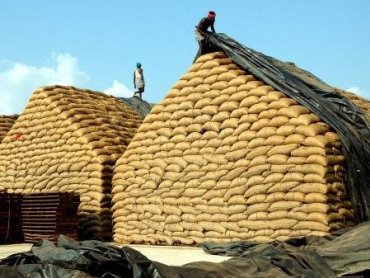New Delhi: The problem of plenty is once again troubling the Indian government as it does not know where to store the bumper grains to be harvested for the third year in a row. Fears are rising that the grains would be out in the open, rot and be eaten by rodents even as millions go hungry in the country which is planning to enact a right to food law.
The government’s plans to create additional storage space have so far moved at a snail’s pace. For instance, of the additional storage capacity of 19 million tonnes (MT) planned by 2012-13 through public-private partnership (PPP), only 0.5 MT could be created till January 2012.
“The states fail to provide land for the purpose,” said a food ministry official, citing the reason for the tardy progress of the scheme.
Experts say the government’s move to attract private players to build warehouses and other infrastructure has not succeeded because it does not offer tax benefits to them.
Biraj Patnaik, adviser to the Supreme Court-appointed food commissioners said: “The government should drop the idea of involving private players in building godowns and let the states do the job.”
With wheat procurement having started this month, the government is looking at a record crop over 90 MT this April-June season.
But the total storage capacity available is 53.4 MT, including 33.4 MT with the Food Corporation of India functioning under the central government, and 20 MT with the states.
Of this, ministry sources said, storage utilisation is 76 percent, leaving around 24 per cent capacity unutilised due to lack of proper planning.
According to one estimate, up to seven percent of the country’s annual grain production goes waste due to insufficient storage space and inefficient transport and distribution networks.
The lack of adequate storage capacity would bother authorities as procurement of wheat from major producing states like Punjab, Haryana and Western Uttar Pradesh picks up. Together, the three states account for over 80 per cent of India’s total production.
One way of solving the problem, Patnaik said, is that the government should distribute more grains among the needy if it is not able to create enough storage capacity.
To reduce stockpiles, the government had allowed traders last year to export wheat and rice surpluses.
The government’s food grain stock up to January 2012 was 46.7 million tonnes. Ministry officials said most states failed to lift the additional 2.5 MT grain allocated to them last year.
To deal with the emerging situation, the finance and food ministries are trying to dovetail a food-for-work scheme with the Mahatma Gandhi National Rural Employment Guarantee Scheme.
But the idea has not found favour with the rural development ministry.
IANS
The opinions, beliefs and viewpoints expressed by authors, news service providers on this page do not necessarily reflect the opinions, beliefs and viewpoints of Hill Post. Any views or opinions are not intended to malign any religion, ethnic group, club, organization, company, or individual.
Hill Post makes no representations as to the accuracy or completeness of any information on this site page.



